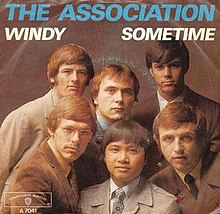Windy (song)
| "Windy" | ||||
|---|---|---|---|---|
 1967 German picture sleeve | ||||
| Single by The Association | ||||
| from the album Insight Out | ||||
| B-side | "Sometime" | |||
| Released | May 1, 1967[1] | |||
| Recorded | 1967 | |||
| Genre | Sunshine pop | |||
| Length | 2:53 | |||
| Label | Warner Bros. | |||
| Songwriter(s) | Ruthann Friedman | |||
| Producer(s) | Bones Howe | |||
| The Association singles chronology | ||||
| ||||
| Audio sample | ||||
"Windy" is a pop music song written by Ruthann Friedman and recorded by the Association.[2] Released in 1967, the song reached No. 1 on the Billboard Hot 100 in July of that year. Overseas, it went to No. 34 in Australia, and No. 3 in Yugoslavia. Later in 1967 an instrumental version by jazz guitarist Wes Montgomery became his biggest Hot 100 hit when it peaked at No. 44.
Not to be confused with The Beach Boys' 1964 song "Wendy", "Windy" was the Association's second U.S. No. 1, following "Cherish" in 1966. Billboard ranked the record as the No. 4 song for 1967. The lead vocals were sung in unison by Russ Giguere and Larry Ramos. Ramos said Ruthann Friedman had written the song about a man, and that the Association changed the lyrics to make it about a woman.[3] Friedman refuted the rumor on her website:[4][dead link]
There are many explanations of who Windy actually was in Ruthann's life. She would have you know, she being me, Ruthann Friedman, that none of them are true. Windy was indeed a female and purely a fictitious character who popped into my head one fine day in 1967 ... During the recording session the Association members, sure that they were in the middle of recording a hit, called the songwriter, me again, in to sing on the fade at the end. I can be heard singing a blues harmony as the song fades out.
Session musician Hal Blaine played drums.[5]
Chart history
Weekly charts
|
Year-end charts
All-time charts
|
Covers
This section may require cleanup to meet Wikipedia's quality standards. The specific problem is: versions may not meet WP:SONGCOVER. (July 2018) |
Wes Montgomery covered the song on his 1967 album A Day in the Life.
Astrud Gilberto covered the song on her 1968 album Windy.
Andy Williams released a version in 1968 on his album Honey.
Barry Manilow and The Association covered the song as a medley with "Cherish" on the 2006 album The Greatest Songs of the Sixties.
See also
References
- ^ "Record Details". 45cat. Retrieved November 11, 2017.
- ^ "Show 37 – The Rubberization of Soul: The great pop music renaissance. [Part 3] : UNT Digital Library" (audio). Pop Chronicles. Digital.library.unt.edu. 1969. Retrieved 2011-04-14.
- ^ Ramos, Larry (August 2011). "Along Comes Larry: A Conversation with Larry Ramos". Confessions of a Pop Culture Addict (Interview). Interviewed by Sam Tweedle. Retrieved 12 December 2016.
Well, the song is not about a girl. It's about a guy. It was written by a gal named Ruthann Friedman, and she wrote it about this guy named Windy. He was a San Francisco/Haight-Ashbury type and if you listen to it with that in mind you can see how it's a totally different type of song than if you think of it being about a girl. It's a happy tune, but if you listen to the lyrics you can see how it's about a guy stoned out of his mind. (Laughs) Windy has stormy eyes / that flash at the sound of lies / and Windy has wings to fly / Up above the clouds. I mean the guy's completely gone! Anyways, the guy died from an O.D. It's sad, but then that's what happens.
- ^ "Ruthann Friedman lyrics". Ruthannfriedman.com. Retrieved 2012-07-11.
- ^ "Windy". Songfacts.com. Retrieved 2015-07-01.
- ^ "Item Display - RPM - Library and Archives Canada". Collectionscanada.gc.ca. 1967-08-05. Retrieved 2018-01-14.
- ^ Flavour of New Zealand, 15 September 1967
- ^ "SA Charts 1965–March 1989". Retrieved 2 September 2018.
- ^ Joel Whitburn's Top Pop Singles 1955–1990 - ISBN 0-89820-089-X
- ^ Cash Box Top 100 Singles, July 8, 1967
- ^ RPM Top 100 Singles of 1967
- ^ Musicoutfitters.com
- ^ Cash Box Year-End Charts: Top 100 Pop Singles, December 23, 1967
- ^ "Billboard Hot 100 60th Anniversary Interactive Chart". Billboard. Retrieved 10 December 2018.
